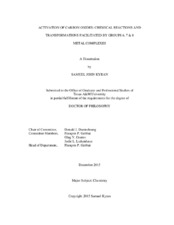| dc.description.abstract | Small molecules carbon dioxide and carbon monoxide produced via the oxidation and partial oxidation of carbonaceous matter, respectively, have distinct chemical functions and reactivity. A fairly stable species and a greenhouse gas, carbon dioxide has risen to an unprecedented level of 400 ppm in the atmosphere by the increased consumption of fossil fuels. To address this undesired accumulation of carbon dioxide, various solutions are being introduced and the utilization of carbon dioxide as a C1 feedstock in chemical synthesis can contribute towards this goal. The levels of carbon monoxide are unaffected as it is relatively short-lived in the atmosphere and is considered a temporary pollutant. High concentrations are toxic to humans due to its ability to displace oxygen from red blood cells. Nanomolar concentrations of carbon monoxide, however, are endogenously-produced and are beneficial to physiology due to its unexpected role as a regulatory molecule. Herein, results on various chemical transformations of carbon dioxide and studies on reactions involving carbon monoxide are presented.
A promising endeavor is the synthesis of polycarbonates from carbon dioxide and epoxides. The use of a naphthalene derived epoxide to produce poly(1,4-dihydronaphthalene carbonate) exhibiting high thermal transitions comparable to bisphenol-A polycarbonate is illustrated. Being a large monomer, employing traditional tert-butyl substituted (salen)Cr(III) catalysts show poor polymer selectivity, whereas the use of a planar tetraazaannulene bound Cr(III) catalyst is successful in chain propagation and subsequently displays higher activity. Fundamental studies on direct carboxylation of hydrocarbons were also investigated. Carbon dioxide insertions into Ru-H and Ru-Me bonds proceed favorably at electron rich metal centers and the formation of an acetate is thermodynamically more stable when compared with formate formation. Bond dissociation energies of acrylates from ruthenium and iron complexes, prepared synthetically as model compounds of an ethylene and carbon dioxide coupled product, were measured through kinetic experiments. Ruthenium complexes show lower BDEs.
Rhenium and manganese carbonyls bound by a hemi-labile pyrrolyl carboxyaldehyde and a bulky diazabutadiene ligand, respectively, are evaluated as carbon monoxide releasing molecules. Additionally, a detailed mechanistic investigation on an unusual carbon monoxide reaction with a synthetic analogue of a biomimetic iron dinitrosyl complex is described. | en |


